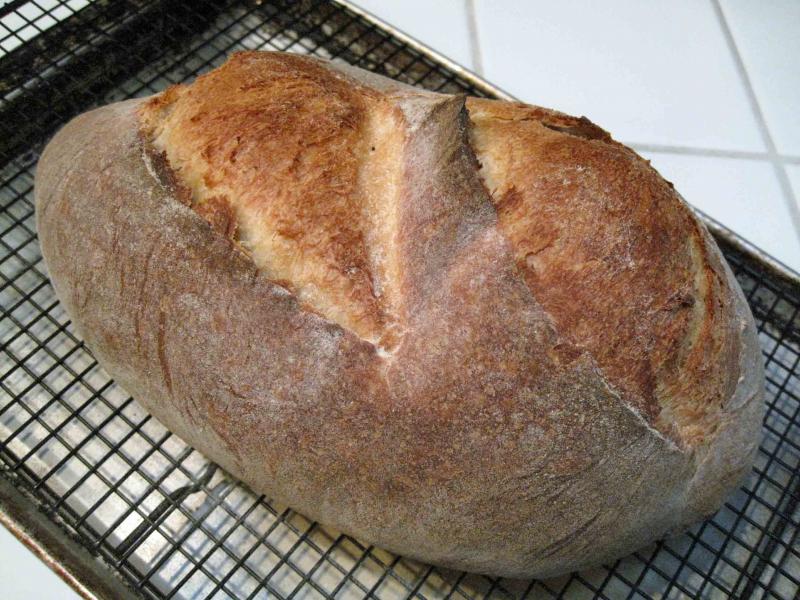
Back in May, 2010, bnom posted a reminiscence of the San Francisco Sourdough bread baked by Larraburu Brothers Bakery, which went out of business about 30 years ago after a fire in their plant. (See Divine inspiration--for me it way Larraburu Brother's SF SD. What was it for you?) For many who grew up eating it, the Larraburu bread was the quintessential San Francisco Sourdough. Although the bakery is long-gone (and much lamented), Doc.Dough found a journal article from 1978 describing their formula and process, so we might attempt to reproduce this famous bread.
Doc.Dough's citation is quoted below, as follows:
Title: Lactic and volatile (C2-C5) organic acids of San Francisco sourdough French bread
Cereal Chemistry 55(4): 461-468; Copyright 1978 The American Association of Cereal Chemists
Authors: A. M. Galal, J. A. Johnson, and E. Varriano-Marston
The Larraburu Company produces San Francisco sourdough French bread by the sponge and dough process. Each day a piece of straight dough or starter sponge known as the "Mother" is saved and refrigerated to be used as a starter sponge the following day. This starter sponge is used to make more starter sponge as well as sponges for bread production. The starter sponge consists of 100 parts of clear flour (14% protein), approximately 50 parts of water, and 50 parts of the starter sponge. The ingredients are mixed and fermented for 9-10 hr at 80°F. The bread dough is made by mixing 100 parts flour 12% protein, 60 parts of water, 15 parts of sponge, and 1.5-2% salt. The dough rests 1 hr and then is divided, molded, and deposited on canvas dusted with corn meal or rice flour. The dough is proofed for 4 hr at 105°F (41°C) and 96% relative humidity and baked at 420°F (216°C) for 40-50 min in a Perkins oven with direct injection of low pressure steam (5 psi). Oven shelves were covered with Carborundum.
Specific instructions for mixing are not provided, but I would surmise that, because of the very short bulk fermentation and long proofing times, Larraburu Brothers used an intensive mix. This would result in a bread with high volume but a relatively dense, even crumb. I altered the procedure to use an autolyse, a less intensive mix, a longer bulk fermentation with a stretch and fold and a shorter proof. My intention was to bake a bread with a more open crumb structure and better flavor.
The autolyse allows the flour to absorb the water and for gluten to start developing. This head start on gluten development allows for a shorter mixing time to get to the desired stage of gluten development. Less mixing has two principal effects: 1) The gluten strands are less organized, resulting in a more open crumb with a random distribution of holes of varying size. 2) Less oxidation of the carotenoid pigments in the flour, resulting in a more yellow crumb color and better bread flavor.
Note that the fermentation and proofing temperature control was made possible by using a Brod & Taylor Proofing Box.
To make one 1 kg loaf:
Sponge (Stiff Levain) | Baker's % | Wt (g) |
High-gluten flour | 100 | 45 |
Water | 50 | 22 |
Stiff starter | 50 | 22 |
Total | 200 | 89 |
Mix thoroughly and ferment for 9-10 hours at 80º F in a lightly oiled bowl, covered tightly.
Final dough | Baker's % | Wt (g) |
AP flour | 100 | 565 |
Water | 60 | 339 |
Salt | 2 | 11 |
Sponge (stiff levain) | 15 | 85 |
Total | 177 | 1000 |
Procedure
Mix the flour and water in a stand mixer with the paddle for 1-2 minutes at Speed 1.
Cover the mixer bowl tightly and autolyse for 20-60 minutes. (I autolysed for 60 minutes.)
Sprinkle the salt on the dough and add the sponge in chunks.
Mix for 1-2 minutes with the paddle at Speed 1, then switch to the dough hook and mix for 5 minutes at Speed 2. Adjust the dough consistency by adding small amounts of water or flour, if needed. (I did not add either.) The dough should be tacky but not sticky. It should clean both the sides and bottom of the mixing bowl.
Transfer the dough to a clean, lightly oiled bowl. Cover tightly.
Ferment at 105º F for 2 1/2 to 3 hours in a humid environment. Stretch and fold once at 1 1/4 hours.
Pre-shape the dough round and cover with a towel or plasti-crap.
Let the dough relax for 15-20 minutes.
Shape as a boule or bâtard.
Proof at 105º F in a floured banneton or en couche, covered, until the dough slowly fills a hole poked in it with a finger. (This was in 30 minutes, for me!)
About 45 minutes before baking, pre-heat the oven to 480º F with a baking stone and steaming apparatus in place.
Transfer the loaf to a peel and score it as desired.
Transfer the loaf to the baking stone. Turn down the oven to 450º F.
Bake with steam for 15 minutes. Remove your steaming apparatus, and bake for another 25 to 35 minutes until the crust is nicely colored and the internal temperature is at least 205º F.
Turn off the oven, but leave the loaf on the baking stone with the oven door ajar for another 10-15 minutes.
Transfer the loaf to a cooling rack, and cool completely (at least 2 hours) before slicing.
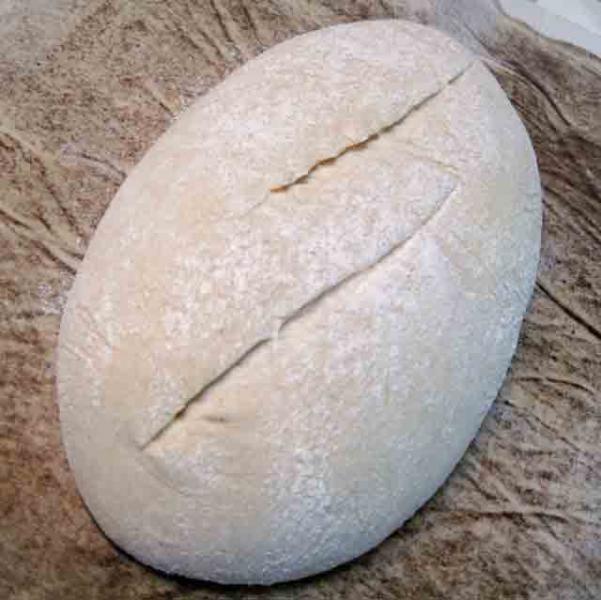
Proofed, slashed and ready to bake
The bread had exuberant oven spring and bloom. In hindsight, it could have proofed for another 15 minutes or so without harm. I baked it for a total of 40 minutes. The crust was very firm, and the loaf sang nicely while cooling. The aroma was that of fresh-baked bread without any yeasty overtones.
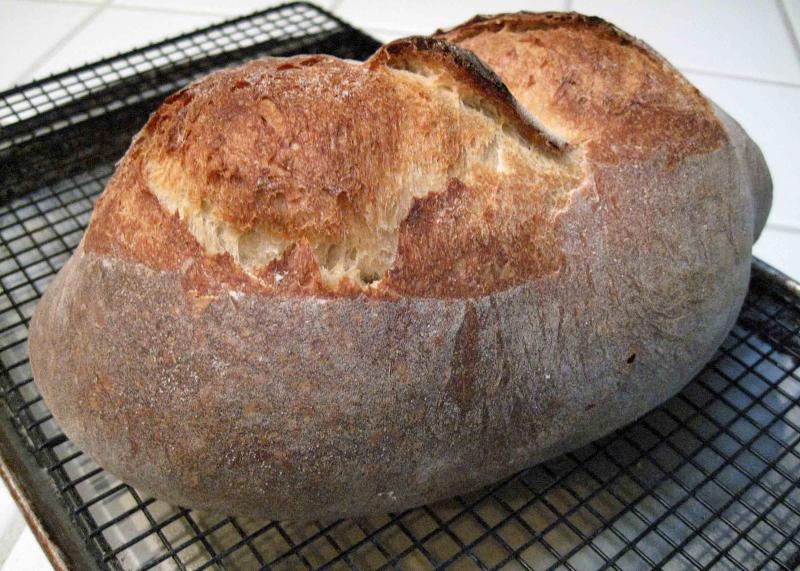
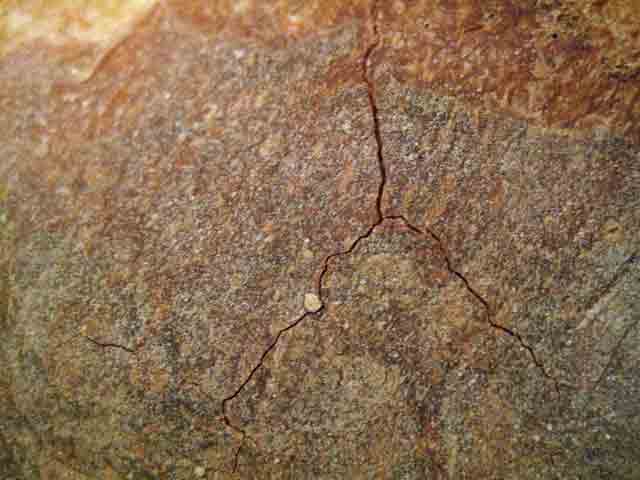
Crackley Crust
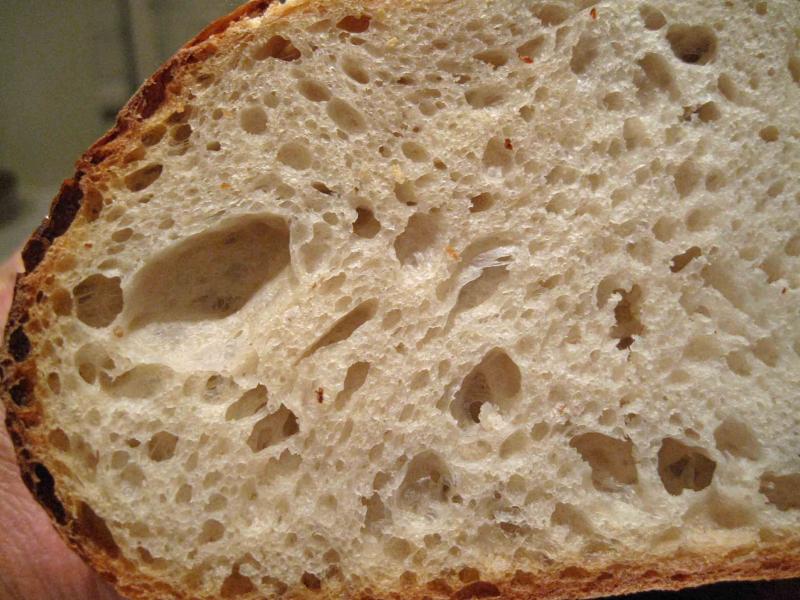
Classic SF SD crumb
I sliced and tasted the bread about 3 hours after it came out of the oven. The aroma of the bread was sweet and wheaty. The crust was very crunchy with a wonderful flavor I have had from the crusts of excellent bakery loaves but not before from my oven. The crumb was quite tender and cool-feeling. The flavor was sweet with only a hint of lactic acid, creamy-type sourness. I could discern no acetic acid presence at all, much to my surprise.
Now, that's not "bad!" I'd say this may be the best flavored French-style pain au levain I've ever made. But it does certainly not have the assertive, vinegary tang usually associated with San Francisco Sourdough. In fact, my wife, who is not at all fond of super-sour sourdoughs, said, "This is better than San Francisco Sourdough!" I try not to argue with her, but it's clearly a matter of taste.
I'm going to give this recipe some thought and may tweak it to get more sourness, but, you know, I may make it just like this again too. It's really outstanding!
David
Submitted to YeastSpotting
- dmsnyder's Blog
- Log in or register to post comments
It looks beautiful and I look forward to the crumb photo and tasting notes! The Larraburu post caught my eye, too, and I copied the formula so I could give it a try. As a one-time San Franciscan who has moved away, I yearn for those old flavors.
-Janie
David,
You are a constant source of inspiration and a fount of knowledge and info for us all. It amazes me that you find the time to bake so much (and create such consistently beautiful loaves and dishes... sigh) while also posting all the great info, tips, narratives and photos you do - all while still holding down a job and having a life too. Thanks for being you!
Lee
It sounds and looks delicious. I enjoyed the blog on the old bread bakery. Maybe, years ago that was the wonderful bread I remembered eating at Fisherman's Wharf. I wish I could package the yeasties living in SF.
Sylvia
The "Wharf Bread" I remember from the 1950's and '60's was baked by "Parisian." It was delicious and moderately sour. I believe I had Larraburu Bros. bread a couple of times. I do remember it as less sour that Parisian and much less sour than Boudin.
I hope some one with a clearer memory than mine of Larraburu's bread will try this recipe and compare it to the original.
David
and write us as usual. Another one to try. Happy New year. Patrick
If you try it, let us know how it turns out for you.
And Happy New Year to you, too!
David
Hi David,
Your own description I'm sure is quite justified.
Whilst I've eaten breads such as Pain Poilane, I've never had a San Francisco Sourdough from the region itself. I was given to understand it is usually distinctly sour. The formula you have posted obviously produces great bread, but with no real sourness to it. Your comments about it being a "matter of taste" are completely fair enough.
I somehow knew you'd sneak another post in before the year was out! The bread looks fantastic, as ever.
All good wishes
Andy
In fact, there is a range of sourness among San Francisco's sourdough bakeries. Many also make a "sweet," i.e., not "sour" bread that may, in fact, be au levain. I don't know.
Personally, I don't much like the most extremely sour breads, but I do like those I consider moderately sour. Being of rather eclectic taste, I do also enjoy a good French-style pain au levain. Really, I've been enjoying that style more over the past year or so. Who knows how my taste will change in the coming year?
A happy, healthy and productive New Year to you!
David
Before I started bread baking, I was a good customer of several of our local bakeries in the San Francisco Bay Area. The "Wharf Bread" from Boudin and Parisian is quite sour, but a number of our local bakeries make a range sourdough breads with the characteristic chewy crumb and chewier crust and varying degrees of sourness. Acme Bread makes a sour one and a sweet one; I believe both are made with levain. Semifreddi also makes a very sour sourdough and a bread similar in most respects, but not very sour at all.
David, I wish your eclectic taste an endless supply of variety in the New Year. And thanks in advance for keeping us apprised of your adventures.
Glenn
Exuberant oven spring indeed, David! Beautiful bloom, and crust.. Lovely in everyway. happy New Year!
David
OK, that formula has lots of interesting twists. I suppose I could try it with some variation due to my current lack of a new-fangled home proofer thingie.
The bread is beautiful.
Happy New Year.
Glenn
Do you recall the character of the Larraburu Bros. sourdough? I do believe you were on solid food before they went out of business.
I'm thinking of making another loaf with an overnight cold retardation.
David
David--
I have no memory of Larraburu Bros. bread, but the collective memory of my adopted city does. Here's a photo from the Western Neighborhoods Project web site:
The same web site has several bulletin board posts about a "comeback" of Larrarburu Bros. bread. Apparently Boudin bought the name (and maybe the mother starter) when Larraburu went bankrupt. Bread with the Larraburu Bros. label has been seen as recently as last year at some Lucky Stores in the area. The bread doesn't match the old timers' memory of the real thing.
Glenn
http://www.outsidelands.org/images/larraburu-vans.jpg
In fact, my project for the next couple days is to try two variations. I mixed starter for 2 kg of dough last night but fermented it at room temperature. I'm going to make 3 loaves - two to bake today and one to retard overnight and bake tomorrow.
Stay tuned for late breaking news!
David
Hello David and Happy New Year,
What a lovely, springy loaf you have there. I'm intrigued by your description of this loaf's flavor!
Also interesting is Syd's comment re: starter's acidity and effect on flavor, as a friend of mine just told me she tastes a little bit of the levain, and based on its sourness then decides whether or not she wants to bake the loaves on the same day as mixing.
Re: the 105F fermentation temperature, I was wondering if that made the dough softer/stickier/any harder to handle?
:^) from breadsong
The dough is very soft and extensible but not sticky or hard to handle at the end of bulk fermentation. Note that this is a pretty low-hydration dough to start with.
As I write, my second experiment with this bread is in the pre-shaped, resting stage. I'll bake a couple loaves tonight to have with homemade pasta with ragu.
BTW, my New Year's new experience is making pasta entirely by hand. It was easier than I had expected/feared to stretch out the dough. My bread and pizza-making experience certainly made it less formidible. And everything I've heard about the superior, rougher surface texture of hand-stretched pasta versus machine-rolled is true! I can hardly wait for dinner!
Happy New Year, and happy baking!
David
Hi David,
Yes, re-reading your formula I see the hydration and now feel a bit silly for asking :^)
I bet the surface texture of your hand-stretched pasta is perfect for helping the sauce to cling to the pasta -
sounds wonderful! Hope you've had a lovely dinner!
:^) from breadsong
I lived out in the Bay Area near the end their reign and your post brings back fond memories. What a delightful post (and bread) to end the year!
Thanks! And Happy New Year!
Jay
And best wishes for the New Year to you!
David
A comment on the demise of the Larruburu Bakery:
I mentioned to David that my brother, who is an avid historian especially with anything relating to the city of our birth, informed me that the bakery didn't fold due to a fire but rather to a law suit that involved an accident with one of their trucks drivers. They lost and had to file bankruptcy...I will attempt to copy my brother's recollections here for anyone who may be interested:
" The case was a very big deal around here when I first started practicing law. Today we commonly hear about billion dollar settlements and verdicts. In those days million dollar awards were almost unheard of. I was working on the merger of Kingsford Charcoal and Clorox in the early 70s. The lead attorney told me that if that merger was screwed up damages could have been in the many tens of millions. When I noticed Clorox’ insurance coverage was far less I asked him about it and he scoffed “Have you ever heard of a $20,000,000 law suit?” Nobody had, so nobody was insured for such an amount. I don’t remember what the figures were in the L. Bread case but would imagine L.B. probably had about $500,000 in coverage, maybe less and the verdict was probably in the $2,000,000 to $3,000,000 range. L.B. was probably a bit underinsured by the standards of the times and the verdict was huge by the standards of the times. My guess is that L.B. was probably in a bit of a tight spot financially as a small local producer and their low insurance coverage may have been an intentional gamble. That is they may have bought less than the recommended amount to save money. (Or they may have obtained their coverage through a small, local mom ‘n pop insurance broker that was not very sophisticated.)"
My copying worked :-)
So, for any other S.F. history buffs, there you have it!
By the way, my brother has just started dabbling in bread baking and, just recently, advance to using S.D. I sent him David's blog piece thinking he might like to give the formula a shot. That will take awhile though as he is still in the experimental stages and swamped with a tight work schedule :-)
Take Care,
Janet
(A displaced S.F. native currently residing in Colorade :-)
Especially LOVE the look of that crumb.
I'm intruiged by this one. The 60% hydration is way lower than any SD I bake. Also, at 15% the starter proportion is relatively low. I'm thinking this suits my current baking conditions.
It's summer here and I'm finding I can't push the BP past 1.5 hours. Lower starter proportion is one way to accommodate the warm ambient temps. I made one of your San Joaquin loaves a couple of days back, and it was lovely. Had somehow slipped off my regular list, but it's firmly back on now. Anyway, that too has a lower starter proportion than most of the formulae I bake, so looking forward to seeing how your Larraburu Brothers SF goes.
By necessity, I'll have to adjust the technique you specify (eg: handmixing with some initial kneading to incorporate the firm starter), and I generally cold-retard for 8 hours after the BP because it suits my schedule. While I won't be replicating your bake exactly, then, I'm still most interested to see how this one turns out, partly because of its departure from the usual, partly because of the history that informed your bake.
One of the wondrous aspects of the web is the facilitation of communities like this one, where important little snippets of local history are so easily globally shared. I'd never heard of the Larraburu Brothers Bakery or its special part in SF SD history, but I can now share a little of the special place it has in the memories of people like you, Bnom, Doc.Dough Sylvia and Janet, both through this thread and following your recipe. Thank you!
BTW, one quick question, pls. Does your Brod & Taylor Proofing Box work in ambient temps warmer than that you wish to proof at, or is it designed to bring temps up, rather than down?
Cheers!
Ross
As you say, there are many unconventional features to this bread, yet it was delicious. I'll post on some variations I'm trying tomorrow.
The proofing box is "one way:" hotter. I wish it did cool. I may have to get a mini-wine cooler. If I could only figure where I could get away with installing it.
Daivd
David--
A wine chiller would be the easy way out. Digging a basement would give you cooler temperatures for slow fermentation, and more room for wine, too. Plus, you'd have room for a deck oven and a sheeter. I suppose you'd need dynamite to get through the hard pan, and the house would have to be jacked up for several months. But think of how pleasant it would be to have a cool place in the Fresno Summer.
Just a suggestion.
Glenn
I have been working on sponge preferment's as I work on Calvel's The Taste of Bread. As I read your notes I'm wondering if you used water to raise the dough temperature to 105F in the mixer or did you stick with 80F and simply set the proofer at the higher temperature? I'm anxiously waiting to hear how your experiments today work out. I have the starter in process now based on your table above.
BTW, what flour did you use for this?
Eric
I didn't attempt to control the dough temperature. I did measure it at the end of today's mix in the Bosch UP. It was 75 degrees F. I relied on the proofer to control temperature .
I used KAF AP for this bread and KAF Sir Lancelot for the high-gluten flour.
Let us know how your bread turns out.
David
David, thanks for the detailed sharing of your experiment with Larraburu sd. I think you've nailed the crust and crumb. Flavorwise, Larraburu had a distinctly sour flavor (along with the sweet wheaty flavor you describe). As I noted in my "Divine Inspiration" post, I've been pretty successful baking breads that give me the tang and the quality of crust I remember from Larraburu. I've used a liquid levain for those breads, but you've used a stiff levain as called for in Doc Dough's citation.
I'm curious what tweaks you'll make to get a more tangly loaf while maintaining the crust and crumb you've achieved.
When my kitchen remodel is completed and I can start baking again (and using my new B&T proofer) I will try your formula and let you know how closely it resembles the bread I grew up on.
The bread was delicious but lacked a sourdough tanginess. I'll be blogging on my variations, probably this evening. I have one more loaf to bake.
The published recipe on which I based this bake is contrary to almost every method I know to increase sourness, so it's a bit of a mystery to me.
David
David,
I baked a loaf of this today and found it strange from the start of mixing on. The high temperatures especially. I can't say it didn't feel right but I was surprised it stayed as tight as it did. I formed a batard and proofed it in the B&T proofer in bakers linen at 105F. I checked at 30 minutes and got the permanent dimple so I baked it.
There is a hint of tang, more than I usually get. The crumb is moist and chewy and the crust is crunchy. The bake was 40 minutes at 450.
Eric
I'm about to upload the results of my second and third bakes of this bread, with modifications of the formula and procedures. More tweaking to be done, but I think progress is being made. See Larraburu two - variations on a classic San Francisco Sourdough.
David
Doubt anyone will see my comment as this subject of the Larraburu bakery is so old----but I was thrilled to run across this.
My great-grandfather founded the Ycre French Bakery in SF in 1906. (yes just before the Earthquake!) I still have his business card. He ran that bakery and lived above it for years. Then he sold out to Parisian. But----he fell on hard times and had to go back to work as a baker in his late 60's. He was employed at Larraburu until he finally retired.
Nice to find this recipe----a little nostalgia. I will try it! Thank you and thanks for the comments from people that know a bit of history of the Baking in San Francisco.
Audrey
Hi Audrey,
did is your great grandfather leave any recipes behind?
Im researching Larraburu and there are various methodologies printed for posterity but I wonder how truly accurate.
Any my info you have would be helpful.
Hello!
Unfortunately, no---my great-grandfather left no recipes either from Larraburu or his previous self-owned bakery. Sad.
Thanks for asking.
Greetings!
I know I may be 10 years late, but I figured I'd still give replying a shot; I am currently doing research on the Ycre French Bakery, and I was wondering if you had any information about this bakery, or the founder (Louis YCRE, if I'm correct?). The reason I ask this here is because the founder (if I am not wrong), actually married someone from my family tree! I'm very aware this is a site for Amateur Bakers and enthusiasts, but your comment is very interesting to me given I have little to no information about them and their business/career.
I'd love to hear all about them, if possible of course!
(I also apologise for the fact I am not as interested in baking and bread as others here, I had to google the answer to the sign-up question just for this reply, hopefully you'll understand!-)
John
I am the great granddaughter of Joseph Fogliacco who was the partner of L. Ycre. I still have their business card. I am not sure of the year that L. Ycre himself sold his half to my great grandfather however Joseph Fogliacco lived above the bakery for years when he was sole owner. Later on my grandfather sold out to Parisian. He then retired for a while but went back to work for Larraburru.
This is amazing! Thank you so much for having taken the time to respond. It's amazing how much you know about your grand-father. L. Ycre was rather well connected with the rest of my direct ancestors, he apparently received a watch with the date of their departure from France engraved at the back. Anyhow, thank you so much for all of this information. I hope you have a wonderful day/evening/night!
Also I will add that this a picture taken in 1906 of the first company my great grandfather worked for upon his arrival from Italy in late March of 1906 (yes just before earthquake which the Ycre bakery survived!). Shortly after his stint here he joined L. Ycre at the Ycre Baking Co. My great grandfather Giuseppe Antonio Fogliacco (he changed his first name to Joseph is the man standing on the left holding a wine glass.
It is absolutely amazing you have kept all of these images, thank you so much for sharing them! It's also very interesting to see Joseph went to a "French-Italian Bakery" before joining L. Ycre.
If you ever are interested to see the information I have collected about L. Ycre, I have set up a genealogical page over Here! Some stuff might be written in French but I'll be sure to change that soon.
All in all thank you very much for these pictures and the information you provided, it helps a ton!
I hope you have a wonderful day/evening
Larraburru's was the first french bread ever tasted. In the 1940's and 50's my famly lived a block away from the bakery on 3rd Ave. and the smell of that bread still is in my memory banks some 70 years later. Larraburru, Parisian, Toscana....all gone now. Everthing's either corporate or "artisan" and you still can't get a decent loaf of french bread in any grocery store that tastes and feels in the mouth the way those old San Francisco brands did. Last I hear, Boudin was stll baking down on Fisherman's Wharf now. They're the last of the last, I guess.
I now reside in Oregon and getting sourdough is impossible in the Salem/Willamette Valley area.
I can't speak for Salem, but Portland has some of the best sourdough bread in the Country right now - Ken's Artisan Bakery, Pearl Bakery - many others I know only by reputation.
David